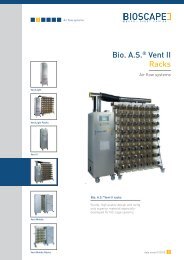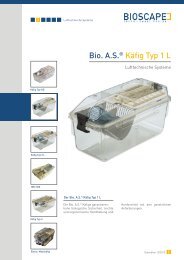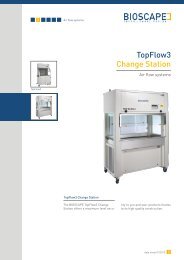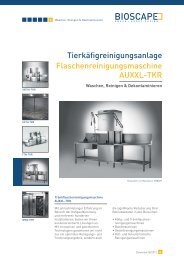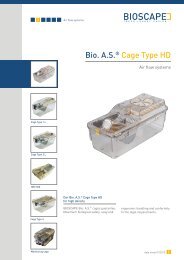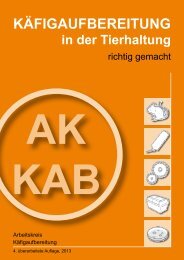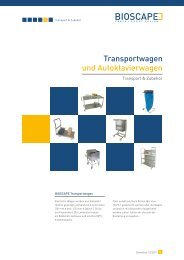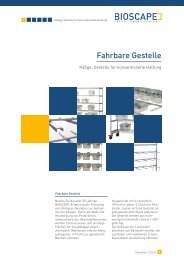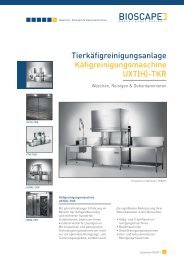CAGE PROCESSING in Animal Facilities - GV-SOLAS
CAGE PROCESSING in Animal Facilities - GV-SOLAS
CAGE PROCESSING in Animal Facilities - GV-SOLAS
Create successful ePaper yourself
Turn your PDF publications into a flip-book with our unique Google optimized e-Paper software.
4.3.2.1.3 R<strong>in</strong>se aidR<strong>in</strong>se aids should achieve an even and sufficient wett<strong>in</strong>g of the different materials of a wash load. They canthus contribute to the dry<strong>in</strong>g process and help avoid spots and drops. Acid r<strong>in</strong>se aids are preferred <strong>in</strong> orderto combat residual water hardness, or to neutralise alkal<strong>in</strong>e softened r<strong>in</strong>s<strong>in</strong>g water. Plastics that are prone tostress cracks, like polycarbonate or polysulfone <strong>in</strong> particular, require specific r<strong>in</strong>se aids.4.3.2.2 Characteristics and physical parameters4.3.2.2.1 Material compatibilityWhen used correctly, chemicals should not cause corrosion or other material damages with<strong>in</strong> the manufacturer-statedlife expectancy of the items that are processed (please refer to chapter 3).4.3.2.2.2 Dispens<strong>in</strong>g and concentrationProcess chemicals can be dispensed centrally or locally (please refer to chapter 5.5). Information on dosageis provided by the manufacturers on the trad<strong>in</strong>g unit labels. For detailed <strong>in</strong>formation, please refer to the correspond<strong>in</strong>gdata sheets.Chemical manufacturers can further list methods for determ<strong>in</strong><strong>in</strong>g the correct concentration (+/- 10% of the setpo<strong>in</strong>t, e.g. titration or conductivity measurement).4.3.2.2.3 TemperatureChemicals must be adequate for the temperature range of a specific wash<strong>in</strong>g procedure, as recommended bythe manufacturers of the items to be washed and mach<strong>in</strong>es to be used.4.3.2.2.4 Replac<strong>in</strong>g the detergentThe detergent solution is to be regenerated or replaced as required. Depend<strong>in</strong>g on the items to be washed,tanks, mesh filters, and jets must be checked regularly and cleaned daily if required (please refer to chapter 6)<strong>in</strong> order to achieve a proper clean<strong>in</strong>g result.4.3.2.3 Documentation and safetyFor every process chemical, manufacturers must provide a data sheet and material safety data sheet. Theoperator must then compile operat<strong>in</strong>g <strong>in</strong>structions. For r<strong>in</strong>se aids, manufacturers must provide a toxicologicalrisk assessment.4.4 Fill<strong>in</strong>g componentsAfter wash<strong>in</strong>g, the cage bases are refilled with bedd<strong>in</strong>g as the bottles are with water. They are thenreturned <strong>in</strong>to the animal facility. Cages and bottles can also be refilled <strong>in</strong> the animal rooms. Thismay require the bedd<strong>in</strong>g and water to be hygienically processed separately.4.4.1 Cage fill<strong>in</strong>g4.4.1.1 Hygienic aspectsWhen cages are refilled, f<strong>in</strong>e dust of clean bedd<strong>in</strong>g can be released. Some wood types can cause allergies,some are classified as carc<strong>in</strong>ogenic. Even if not classified as dangerous, however, airborne f<strong>in</strong>e dust is tobe m<strong>in</strong>imised and where necessary to be exhausted when occurr<strong>in</strong>g <strong>in</strong> the work place <strong>in</strong> order to protect theoperat<strong>in</strong>g staff as best as possible. (Please consult the labour protection laws of your respective country/EUstandards.)Cage Process<strong>in</strong>g <strong>in</strong> <strong>Animal</strong> <strong>Facilities</strong> · 4th issue · 2013 25



